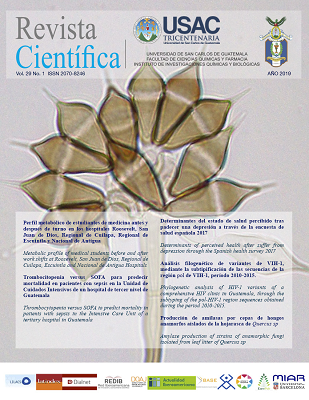Metabolic Profile of Medical Students Before and After Work Shifts at Roosevelt, San Juan de Dios, Regional de Cuilapa, Escuintla and Nacional de Antigua Hospitals
DOI:
https://doi.org/10.54495/Rev.Cientifica.v29i1.44Keywords:
hydrocortisone, physiological stress, blood glucose, Medical studentsAbstract
The long work shifts of 16 and 24 hours and up to 32 to 36 hours that doctors have in the hospital, exert a negative effect on their physical and emotional health. Alterations have been described in the levels of glycaemia, catecholamines, cortisol, heart rate, among others. This research aimed to compare the metabolic profile of internal and external medical students of the Faculty of Medical Sciences of the University of San Carlos de Guatemala, before and after their hospital shifts. This paired study was carried out in many national hospitals, such as: Hospital Nacional Roosevelt, Hospital General San Juan de Dios, Hospital Regional Cuilapa, Hospital Regional de Escuintla and Hospital Nacional de Antigua. Glycaemia, lipid profile and cortisol; vital sings, and lifestyles before and after shifts were evaluated in 80 students. Significant variation was observed in cortisol values (p = .023), glycaemia (p = .002) y triglycerides (p = .050) before and after the work shift. After the work shift the student experienced an increase in cortisol values and a decrease in glycaemia and triglyceride levels. These changes were associated to the different hospitals.
Downloads
References
Anguiano, D. (2012). Relación entre niveles de glucosa, carga académica y desempeño escolar en universitarios del campus Minatlán (Tesis de licenciatura). Universidad veracruzana, Veracruz.
Barriga-Ibars, C., Rodríguez-Moratinos, A., Esteban S., & Rial, R. (2005). Interrelaciones entre el sueño y el estado inmune. Revista de neurología, 40(9), 548-556. https://doi.org/10.33588/rn.4009.2005250 DOI: https://doi.org/10.33588/rn.4009.2005250
Busxton, O. M., Cain, S. W., O’Connor, S. P., Porter, J. H., Duffy, J. F., Wang, W., … Shea, S. A. (2012). Adverse metabolic consequences in humans of prolonged sleep restriction combined with circadian
disruption. Science translational medicine, 4(129), https://doi.org/10.1126/scitranslmed.3003200 DOI: https://doi.org/10.1126/scitranslmed.3003200
Ceballos, G., Del Gordo, R., & Campo-Arias, A. (2006). Factores asociados con el consumo diario de cigarrillo en estudiantes de medicina de Santa Marta, Colombia. Revista nacional de salud pública, 24(1), 79-83.
Chin, J., Merves, M., Goldberger, B., Sampson-Cone, A., & Cone, E. (2008). Caffeine content of brewed teas. Journal of analytical toxicology, 32(8), 702-704. https://doi.org/10.1093/jat/32.8.702 DOI: https://doi.org/10.1093/jat/32.8.702
Cote-Menéndez, M., Rangel-Garzón, C., Sánchez-Torres, M., & Medina-Lemus, A. (2011). Bebidas energizantes: ¿Hidratantes o estimulantes?. Revista de la facultad de medicina, 59(3), 255-266.
Darcia, S. (2016). Implicaciones del trabajo nocturno y/o trabajo por turnos Sobre La salud. Medicina legal de Costa Rica, 33(1), 70-78.
Departamento de salud mental y abuso de sustancias. (2010). Estrategia mundial para reducir el uso nocivo de alcohol. Geneva, Switzerland: World Health Organization. Retrieved from
who.int/substance_abuse
Kiranmala, K., Aslam, M., Mishra, B. K., Jhamb, R., & Madhu, S. V. (2019). Association of postprandial triglyceride responses with insulin resistance among rotational night shift healthcare workers. Experimental physiology, 104(6), 819-825. https://doi.org/10.1113/EP087514 DOI: https://doi.org/10.1113/EP087514
Li, J., Bidlingmaier, M., Petru, R., Pedrosa Gil, F., Loerbroks, A., & Angerer, P. (2018). Impact of shift work on the diurnal cortisol rhythm: a one-year longitudinal study in junior physicians. Journal of
occupational medicine and toxicology, 13(1), 23.https://doi.org/10.1186/s12995-018-0204-y DOI: https://doi.org/10.1186/s12995-018-0204-y
Mazariegos, E., & Herrera, M. (2009). Normativo general externos, carrera médico y cirujano (2nd ed.). Guatemala: Editorial universitaria, Universidad de San Carlos de Guatemala.
Moore-Ede, M., C., & Amis, E. (2010). The new recommendations on duty hours from the ACGME task force. New England journal of medicine, 363(2),
https://doi.org/10.1056/NEJMsb1005800 DOI: https://doi.org/10.1056/NEJMsb1005800
Programa Nacional de Enfermedades Crónicas. (2008). Plan de acción 2008 – 2012 para la prevención y el control integral de las enfermedades crónicas y sus factores de riesgo. Guatemala: Ministerio de salud pública y asistencia social.
Santos, E. (2007). Llevo 32 horas sin dormir, ¿te opero? Retrieved from http://www.dsalud.com/index.php?pagina=articulo&c343
Smith-Coggins, R., Rosekind, M., Buccino, K., Dinges, D., & Moser, R. (1997). Rotating shiftwork schedules: can we enhance physician adaptation to night shifts? Academic emergency medicine#: Official journal of the society for academic emergency medicine, 4(10), 951-961. https://doi.org/10.1111/j.1553-2712.1997.tb03658.x DOI: https://doi.org/10.1111/j.1553-2712.1997.tb03658.x
Waterhouse, J., & Dphil, B. (1999). Jet-lag and shift work: (1) circadian rhythms. Journal of the royal society of medicine, 92(8), 298-401. https://doi.org/10.1177/014107689909200804 DOI: https://doi.org/10.1177/014107689909200804
Downloads
Published
How to Cite
Issue
Section
License
Copyright (c) 2019 Oscar Castillo-Ochoa, María Pinto-Zelada, Cathleen Beza-González, Samuel Martínez-Ortiz, María López-Rodriguez, Rita Menéndez-Salguero, André Marroquín-Sierra, Maria Gómez-Coronado, André Chocó-Cedillos, Juan Moreira-Díaz

This work is licensed under a Creative Commons Attribution 4.0 International License.
Los autores/as que publiquen en esta revista aceptan las siguientes condiciones:
- Los autores/as conservan los derechos de autor y ceden a la revista el derecho de la primera publicación, con el trabajo registrado con la licencia de atribución de Creative Commons 4.0, que permite a terceros utilizar lo publicado siempre que mencionen la autoría del trabajo y a la primera publicación en esta revista.
- Los autores/as pueden realizar otros acuerdos contractuales independientes y adicionales para la distribución no exclusiva de la versión del artículo publicado en esta revista (p. ej., incluirlo en un repositorio institucional o publicarlo en un libro) siempre que indiquen claramente que el trabajo se publicó por primera vez en esta revista.
- Se permite y recomienda a los autores/as a compartir su trabajo en línea (por ejemplo: en repositorios institucionales o páginas web personales) antes y durante el proceso de envío del manuscrito, ya que puede conducir a intercambios productivos, a una mayor y más rápida citación del trabajo publicado.







